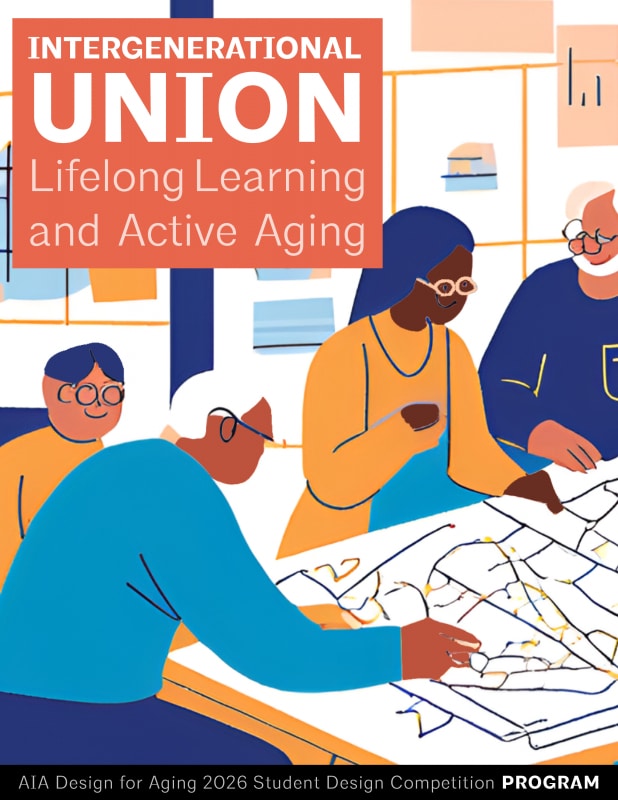Registration Deadline: April 8, 2026
2026 Design for Aging Competition
AN INTERGENERATIONAL UNION:
A Campus-Integrated Hub for Lifelong Learning and Active Aging
Registration & Rules
AN INTERGENERATIONAL UNION: A Campus-Integrated Hub for Lifelong Learning and Active Aging
Registration
Faculty to Complete One Online Registration for Each Entry
An ACSA member school, faculty sponsor is required to enroll students online (available at www.acsa-arch.org) by April 8, 2026. Registration can be done for your entire studio or for each individual student or team of students participating. Students or teams wishing to enter the competition on their own must have a faculty sponsor, who should complete the registration. There is no entry or submission fee to participate in the competition. Each registered student and faculty sponsor will receive a confirmation email that will include information on how the student(s) will upload final submissions online. Please add the email address competitions@acsa-arch.org to your address book to ensure that you receive all emails regarding your submission.
During registration the faculty will have the ability to add students, add teams, assign students to teams, and add additional faculty sponsors. Registration is required by April 8, 2026, but can be changed, edited, and added to until a student starts a final submission; then the registration is no longer editable.
Registration Steps
- Faculty log into the ACSA website,
- Click the “Register your Students” button,
- Select the 2026 Design for Aging Competition from the submission type dropdown menu & Click “Enter”,
- Select “Individual Registration” to add individual student. Click “Save and Continue”. You will need to know each student’s first & last names, email, & institution, which are all required fields for each student,
- Select “Team Registration” if this is a team registration, you may add additional students by clicking “Add Student” to the same submission to this team, teams must be limited to a maximum of five students,
- Once the individual student or team is complete, Click “Submit”
- Repeat steps 3 – 6 for each individual or team.
Faculty Responsibility
The administration of the competition at each institution is left to the discretion of the faculty within the guidelines set forth in this document. Work on the competition should be structured over the course of one semester during the 2025-2026 academic year.
Each faculty sponsor is expected to develop a system to evaluate the students’ work using the criteria set forth in this program. The evaluation process should be an integral part of the design process, encouraging students to scrutinize their work in a manner similar to that of the jury.
The intent of this competition is to provide an academically rigorous design challenge suitable for integration into the curriculum of an architectural design studio or course. Curriculum integration is not a requirement of competition guidelines but is strongly encouraged. The administration of the competition at each institution is left to the discretion of the faculty within the guidelines set forth in this document.
Artificial Intelligence (AI)
Advancements in artificial intelligence (AI) and computational design are providing students and architects with new labor-saving tools and transforming many of the tasks associated with project delivery. The proliferation of AI use in practice and academia is raising legitimate questions about how the responsibility and accountability of the architect and students might be altered by this technological wave.
- AI usage in student submissions must ensure the students remain responsibly in control and continue to be accountable for all images and likenesses in their submissions.
- AI is a tool — it is not a replacement for professional judgment. Regardless of the AI tools used, it remains the architecture student’s responsibility to provide designs in conformance with academic integrity.
Students choosing to use AI as a tool must attribute this use in their design essay (abstract). Students are accountable for the originality, validity, and integrity of the content and designs of their submissions. In choosing to use AI tools, students are expected to do so responsibly and with a high standard of ethical conduct. This includes reviewing the outputs of any AI tools and confirming content accuracy.
Building Code
Refer to the International Building Code and the local zoning ordinance for information on parking requirements, height restrictions, setbacks, easements, flood, egress and fire containment. All proposals must be designed to meet requirements for accessibility; for guidelines, refer to the Americans with Disabilities Act and the principles of Universal Design.
Digital Submission Format
Submissions must be presented on four 20” x 30” digital boards. All boards are required to be uploaded through the ACSA website as BMP, GIF, JPEG, JPG, or PNG files. The names of student participants, their schools, or faculty sponsors, must NOT appear on the boards, or in the project title or project title file name(s).
Design Essay or Abstract
A brief essay, 300 words maximum, is required as part of the submission describing the most important concepts of the design project. Keep in mind that the presentation should graphically convey the design solution and context, and not rely on the design essay to convey a basic understanding of the project. The names of student participants, their schools, or faculty sponsors, must NOT appear in the design essay. This abstract is included in the final online submission, completed by the student(s) in a simple copy/paste text box.
Program Summary or Narrative
The Program Summary or Narrative, 300-word maximum, is submitted by the student(s) in a simple copy/paste text box. It should include the total gross area along with clarity of included spaces. Please explain the rationale behind the selection, organization, and sizing of program spaces. Students should describe how their spatial strategy supports:
- Intergenerational interaction and shared use of space
- A diversity of needs and care levels (e.g., active adults, assisted living, memory care)
- Daily life activities including wellness, learning, dining, and recreation
- The values embedded in the Surgeon General’s Six Pillars of Social Connection
- Principles emphasizing human-scale, shared spaces, and intentional community building that foster daily interaction, mutual support, and resident engagement.
Narratives should also address how interior and exterior spaces are scaled to promote accessibility, flexibility, and inclusion. Consider how dimensions were informed by resident needs, local context, or program adjacencies, and how these decisions enhance user well-being, autonomy, and community belonging.
Required Submission Documents
Submissions must include (but are not limited to) the following required drawings:
- Site plan (with north arrow) showing proposal in its context of surrounding buildings and topography, together with details of access/circulation;
- Floor plans, for each unit, to show program elements, spatial adjacencies and navigation strategies;
- Elevations & sections sufficient to show site context and major spatial and program elements;
- Three-dimensional representations – in the form of perspectives, axonometrics showing the proposal in its context, montages and/or physical model photographs – to illustrate the character of the project;
- Large scale drawing(s), either orthographic or three dimensional, illustrating integrated design
Incomplete or undocumented entries will be disqualified. All drawings should be presented at a scale appropriate to the design solution and include a graphic scale.
ONLINE PROJECT SUBMISSION
The student is required to submit the final entries that must be uploaded through the ACSA Competition website at www.acsa-arch.org by 11:59 pm, Pacific Time, on June 3, 2026. If the submission is from a team of students, all student team members will have the ability to upload the digital files. It is recommended that one team member completes the final submission upload. Faculty have the option to submit the student’s final boards when needed. The submission is not complete until the “submit” button has been clicked. Once the final submission is uploaded and submitted, each student will receive a confirmation email notification.
The final submission upload must contain the following:
- Completed online registration including all team members and faculty sponsors,
- Each of the four 20”x30” boards uploaded individually as high resolution BMP, GIF, JPEG, JPG, or PNG files, no more than 20MB each,
- A design essay or abstract (300 words maximum)
- A program summary diagram/text of spaces and areas (300 words maximum).
The names of student participants, their schools and faculty sponsors must NOT appear on the boards, abstract, program summary, or in the file name.
Winning projects will be required to submit high-resolution original files/images for use in competition publications and exhibit materials. By uploading your files, you agree that the Association of Collegiate Schools of Architecture (ACSA) has the rights to use your winning submission, images and materials in a summary publication, online and in promotional and exhibition resources. ACSA will attribute authorship of the winning design to you, your team, faculty and affiliation. Additionally, you hereby warrant that the submission is original and that you are the author(s) of the submission.
Competition Organizers & Sponsors
Questions
Edwin Hernández-Ventura
Programs Coordinator
ehernandez@acsa-arch.org
202.785.2324
Eric W. Ellis
Senior Director of Operations and Programs
eellis@acsa-arch.org
202-785-2324

 Study Architecture
Study Architecture  ProPEL
ProPEL 


